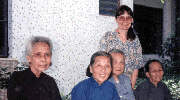
|

|
|
During the nineteenth century, the Sun Duk district in southern China's Pearl River Delta was renowned for the quality of its silk and the independence of its women. Because silkworms demand round-the-clock care, the labor of every family member--including children as young as five--was needed, and the custom of footbinding was not practiced here. Furthermore, unmarried daughters were permitted to keep their earnings from reeling silk, and with economic independence possible, girls could--and did--resist marriage. Where families hired married women with many children to recomb a bride's childish plaits into a matronly bun to signify her transition from girl to woman, daughter to wife (and hopefully mother of many children), marriage resisters combed up their own hair to signify their commitment to lives of self-reliance. The marriage resisters also made vows of lifelong spinsterhood. Since these vows did not preclude sexual intimacy with other women, some independent spinsters lived as couples. More often, they lived communally in spinster houses. In either case, it was not uncommon for them to take in unwanted girls and raise them as daughters. The first record of self-combing was in 1837, and the practice flourished in Sun Duk for 100 years. Although it spread to the neighboring districts of Poon Yu and Nam Hoi, it wasn't ever as prevalent. Similarly, when the silk industry went into decline in the early part of the twentieth century and independent spinsters in Sun Duk left to work in Singapore and Hong Kong, girls in these cities emulated them, but their numbers never became significant. As a girl in Hong Kong in the 1940s and 50s, I was familiar with independent spinsters who were laboring as servants, and I was deeply impressed by their courage in resisting long accepted norms, their ability to lead lives in which they governed themselves. Their example allowed me to believe that I could too and gave me the strength to leave Hong Kong for America in 1962 at the age of 16. From books, newspapers, movies, and Americans living in or passing through Hong Kong, I had some idea--albeit much of it false--about the future I might make for myself in the United States. Even so, it seemed as elusive and impossible to grasp as the moon pearl. But for girls in early nineteenth century Sun Duk, a life of independent spinsterhood would have been completely unknown, and in the 1990s, I began to wonder how the first independent spinsters were able to conceive lives of self-rule. I also wondered how they were able to win acceptance, admiration, and respect in Sun Duk in the 1830s when spinsters, same-sex couples, and single women who wish to adopt children continue to be marginalized in the United States at the beginning of the twenty-first century. By the 1990s, however, the independent spinsters of my childhood had either died or retired to spinster houses, vegetarian halls, and old people's homes in China. Fortunately, interviewers from the Hong Kong Museum of History and the National Archives of Singapore as well as a handful of academics had preceded me in seeking the answers to some of these questions. Moreover, I was able to interview four elderly selfcombers in Shiqiao, who spoke frankly of their own experiences and those of their sisters and friends. From this research, I realized that what made life possible for the independent spinsters was their recognition that independence and community were not exclusive states. And, looking back on my thirty plus years in America, I could see this was true of my own life. My understanding was greatly deepened, however, by a near fatal car accident in 1995: for many months, I was bedridden then wheelchair dependent; yet my community of family and friends made it possible for me to continue living and working much as I had before my accident. All the independent spinsters interviewed--whether by others or myself--had the example of those who preceded them. Of necessity, then, THE MOON PEARL--which tells the story of the first girls to comb up their own hair and make vows of spinsterhood--is a work of my imagination. The ceremonies, cultural beliefs, and practices depicted are those of nineteenth century Sun Duk though. And even today the pursuit of the moon pearl continues the world over. |